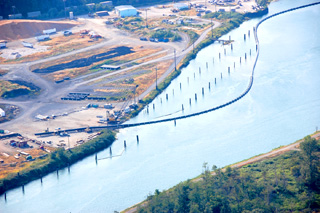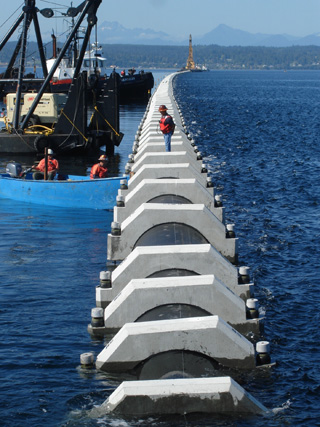|
Subscribe / Renew |
|
|
Contact Us |
|
| ► Subscribe to our Free Weekly Newsletter | |
| home | Welcome, sign in or click here to subscribe. | login |
Construction
| |
 |
July 7, 2011
Crews worked quickly to install marine outfall
King County

Lundt
|
County staff and contractors working on Brightwater’s deep-water marine outfall project couldn’t have been happier when they learned their project was finally sunk.
During a week in 2008, two mile-long pipelines earlier built at a Port of Everett site on the Snohomish River were carefully lowered to the Puget Sound seafloor after being towed 17 nautical miles to Point Wells, near Shoreline, and connected to Brightwater’s 13-mile conveyance tunnel.
Today the outfall pipes and their twin 250-foot diffusers are resting comfortably a mile off Point Wells at a depth of about 600 feet, waiting to serve as the primary discharge point for highly treated wastewater when the Brightwater treatment plant and conveyance tunnel begins operating.
As one of the world’s deepest municipal outfalls, construction involved a complex and meticulous coordination of engineering, marine construction and environmental permitting that required a highly skilled team of professionals with unique, specialized experience.
King County awarded the design-bid contract to Triton Marine Construction of Bremerton in 2007, and the project team hit the ground running on an aggressive, single-season schedule.
Open-trench construction
Design decisions were largely driven by the need to build an outfall with a 75-year operating life using durable, corrosion-resistant materials that would meet stringent seismic standards and, most importantly, the hydraulic requirements to enable treated effluent to mix effectively with the waters of Puget Sound.
The construction team mobilized in 2008 as design was finalized, and soon began shoring and trench excavation work at Point Wells. The work required close coordination with the Washington Department of Fish and Wildlife as well as close monitoring of construction activities to minimize impacts to environmentally sensitive nearshore habitat and migratory fish runs.
Starting on the beach at a depth of 20 feet below grade, contractors connected to a microtunnel from the conveyance tunnel and installed 400 feet of 84-inch-diameter steel pipe up the beach to a wye plus a seismic anchor, which was buried below natural grade at 4 feet below mean lower low water (MLLW), a measurement that refers to the average lowest daily low tide.
Shored open-trench construction was used for pipeline installation from the connection on the beach to 30 feet below MLLW. The trench was open cut with side slopes from 30 to 80 feet below MLLW, where the pipelines daylighted. Triton built a temporary work platform in the nearshore area to provide access to the pipe alignment in shallow water.
Throughout planning, design and construction, King County worked closely with scientists from the University of Washington and the state departments of Fish and Wildlife and Natural Resources to survey and monitor the intertidal zone, which helped support later restoration efforts.
Success with design-build
From the seismic anchor on, the outfall was eventually connected to twin 5-foot-diameter, 5,000-foot-long high-density polyethylene pipes with concrete ballast anchors that ended with a 250-foot-long diffuser section composed of 30 6-inch-diameter ports. The diffusers are staggered along the alignment to provide a 500-foot-long mixing zone.
The twin pipes were built and assembled near Langus Waterfront Park, at the Port of Everett site on the Snohomish River. The pipe sections were fused together and fitted with concrete collars. When each section was completed, a crane lifted and pushed it into the river, where the pipes were moored until September of 2008.
One of the greatest challenges was the actual outfall construction, which entailed towing the two pipes from the assembly site to Point Wells. The pipe connection and the controlled submergence had to occur within an exceptionally narrow 50-foot easement, and the team successfully met the challenge with near perfection. Each pipe took a full day to submerge.
The Triton-led team completed the outfall project in late 2008, 22 months ahead of schedule and for $29 million, or 23 percent less than the originally estimated cost. Additionally, it was completed with no permit or water-quality violations.
While King County’s clean-water utility has managed wastewater outfall construction projects before, the Brightwater outfall marks the first time a design-build procurement process was used.
The county believes it was an important factor in the overall project’s success because it enabled close collaboration as well as risk sharing on things like materials price escalation. King County was also able to put more emphasis on contractor qualifications, which was an important consideration given the complexity and unique parameters of the project. Finally, the design team and the builder were able to be in sync from the beginning, which helped King County avoid costly redesign work experienced on prior outfall projects.
In King County’s view, Brightwater’s marine outfall project underscored a commitment to protect public health and the environment while maximizing the investment of ratepayer money in critical infrastructure.
Jeff Lundt served as King County’s project manager for the Brightwater marine outfall design-build project.
Other Stories:
- Brightwater design weds form and function
- Public process helped make Brightwater a reality
- Designed to be a good neighbor
- A look around Brightwater
- A place for hands-on environmental education




